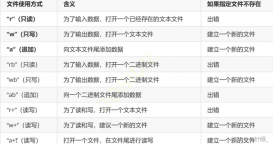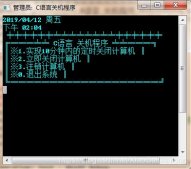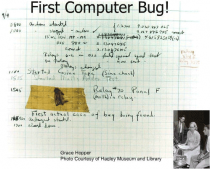解释器模式(interpreter),给定一个语言,定义它的文法的一种表示,并定义一个解释器,这个解释器使用该表示来解释语言中的句子。
解释器模式需要解决的是,如果一种特定类型的问题发生的频率足够高,那么可能就值得将该问题的各个实例表述为一个简单语言中的句子。这样就可以构建一个解释器,该解释器通过解释这些句子来解决该问题。当有一个语言需要解释执行,并且你可将该语言中的句子表示为一个抽象语法树时,可使用解释器模式。用了解释器模式,就意味着可以很容易地改变和扩展文法,因为该模式使用类来表示文法规则,你可使用继承来改变或扩展该文法。也比较容易实现文法,因为定义抽象语法树中各个节点的类的实现大体类似,这些类都易于直接编写。
结构图:

实例:
音乐解释器
playContext.h
|
1
2
3
4
5
6
7
8
9
10
11
12
13
14
15
16
17
18
19
20
21
22
23
24
|
/************************************************************************ * description: 演奏内容 * remark: ************************************************************************/#ifndef _PLAY_CONTEXT_H_ #define _PLAY_CONTEXT_H_ #include <string> #include <iostream> using namespace std; class playContext { public: string getPlayText() { return m_strText; } void setPlayText(const string& strText) { m_strText = strText; } private: string m_strText; }; #endif// _PLAY_CONTEXT_H_ |
expression.h
|
1
2
3
4
5
6
7
8
9
10
11
12
13
14
15
16
17
18
19
20
21
22
23
24
25
26
27
28
29
30
31
32
33
34
35
36
37
|
/************************************************************************ * description: 表达式类 * remark: ************************************************************************/#ifndef _EXPRESSION_H_ #define _EXPRESSION_H_ #include "playContext.h" class expression { public: // 解释器 void interpret(playContext& PlayContext) { if (PlayContext.getPlayText().empty()) { return; } else { string strPlayKey = PlayContext.getPlayText().substr(0, 1); string strtemp = PlayContext.getPlayText().substr(2); PlayContext.setPlayText(strtemp); size_t nPos = PlayContext.getPlayText().find(" "); string strPlayValue = PlayContext.getPlayText().substr(0, nPos); int nPlayValue = atoi(strPlayValue.c_str()); nPos = PlayContext.getPlayText().find(" "); PlayContext.setPlayText(PlayContext.getPlayText().substr(nPos + 1)); excute(strPlayKey, nPlayValue); } } // 执行 virtual void excute(string& strKey, const int nValue) = 0; private: }; #endif// _EXPRESSION_H_ |
note.h
|
1
2
3
4
5
6
7
8
9
10
11
12
13
14
15
16
17
18
19
20
21
22
23
24
25
26
27
28
29
30
31
32
33
34
35
36
37
38
39
40
41
42
43
44
45
46
|
/************************************************************************ * description: 音符类 * remark: ************************************************************************/#ifndef _NOTE_H_ #define _NOTE_H_ #include "expression.h" class note : public expression { public: virtual void excute(string& strKey, const int nValue) { char szKey[2]; strncpy(szKey, strKey.c_str(), strKey.length()); string strNote; switch (szKey[0]) { case 'C': strNote = "1"; break; case 'D': strNote = "2"; break; case 'E': strNote = "3"; break; case 'F': strNote = "4"; break; case 'G': strNote = "5"; break; case 'A': strNote = "6"; break; case 'B': strNote = "7"; break; default: strNote = "error"; break; } cout << strNote << " "; } }; #endif// _NOTE_H_ |
scale.h
|
1
2
3
4
5
6
7
8
9
10
11
12
13
14
15
16
17
18
19
20
21
22
23
24
25
26
27
28
29
30
31
32
33
|
/************************************************************************ * description: 音阶类 * remark: ************************************************************************/#ifndef _SCALE_H_ #define _SCALE_H_ #include "expression.h" class scale : public expression { public: virtual void excute(string& strKey, const int nValue) { string strScale; switch (nValue) { case 1: strScale = "低音"; break; case 2: strScale = "中音"; break; case 3: strScale = "高音"; break; default: strScale = "error"; break; } cout << strScale << " "; } private: }; #endif// _SCALE_H_ |
speed.h
|
1
2
3
4
5
6
7
8
9
10
11
12
13
14
15
16
17
18
19
20
21
22
23
24
25
|
#ifndef _SPEED_H_ #define _SPEED_H_ #include "expression.h" class speed : public expression { public: virtual void excute(string& strKey, const int nValue) { string strSpeed; if (nValue < 3) { strSpeed = "快速"; } else if (nValue >= 6) { strSpeed = "慢速"; } else { strSpeed = "中速"; } cout << strSpeed << " "; } }; #endif// _SPEED_H_ |
客户端: InterpreterApp.cpp
|
1
2
3
4
5
6
7
8
9
10
11
12
13
14
15
16
17
18
19
20
21
22
23
24
25
26
27
28
29
30
31
32
33
34
35
36
37
38
39
40
41
42
43
44
45
46
47
48
49
|
// InterpreterApp.cpp : 定义控制台应用程序的入口点。 // #include "stdafx.h" #include "note.h" #include "scale.h" #include "speed.h" #include "playContext.h" int _tmain(int argc, _TCHAR* argv[]) { playContext context; cout << "Music:"; context.setPlayText("T 2 O 2 E 3 G 5 G 5 "); expression* expressObj = NULL; while (!context.getPlayText().empty()) { string strSep = context.getPlayText().substr(0, 1); char szKey[2]; strncpy(szKey, strSep.c_str(), strSep.length()); switch (szKey[0]) { case 'O': expressObj = new scale(); break; case 'T': expressObj = new speed(); break; case 'C': case 'D': case 'E': case 'F': case 'G': case 'A': case 'B': case 'P': expressObj = new note(); break; default: break; } if (NULL != expressObj) { expressObj->interpret(context); } } system("pause"); return 0; } |
不足之处
解释器模式不足的是,解释器模式为文法中的每一条规则至少定义了一个类,因此包含许多规则的文法可能难以管理和维护。建议当文法非常复杂时,使用其他的技术如语法分析程序或编译器生成器来处理。
适用场景
- 当有一个语言需要解释执行, 并且你可将该语言中的句子表示为一个抽象语法树时,可使用解释器模式。而当存在以下情况时该模式效果最好:
- 该文法简单对于复杂的文法, 文法的类层次变得庞大而无法管理。此时语法分析程序生成器这样的工具是更好的选择。它们无需构建抽象语法树即可解释表达式, 这样可以节省空间而且还可能节省时间。
- 效率不是一个关键问题最高效的解释器通常不是通过直接解释语法分析树实现的, 而是首先将它们转换成另一种形式。例如,正则表达式通常被转换成状态机。但即使在这种情况下, 转换器仍可用解释器模式实现, 该模式仍是有用的。
















